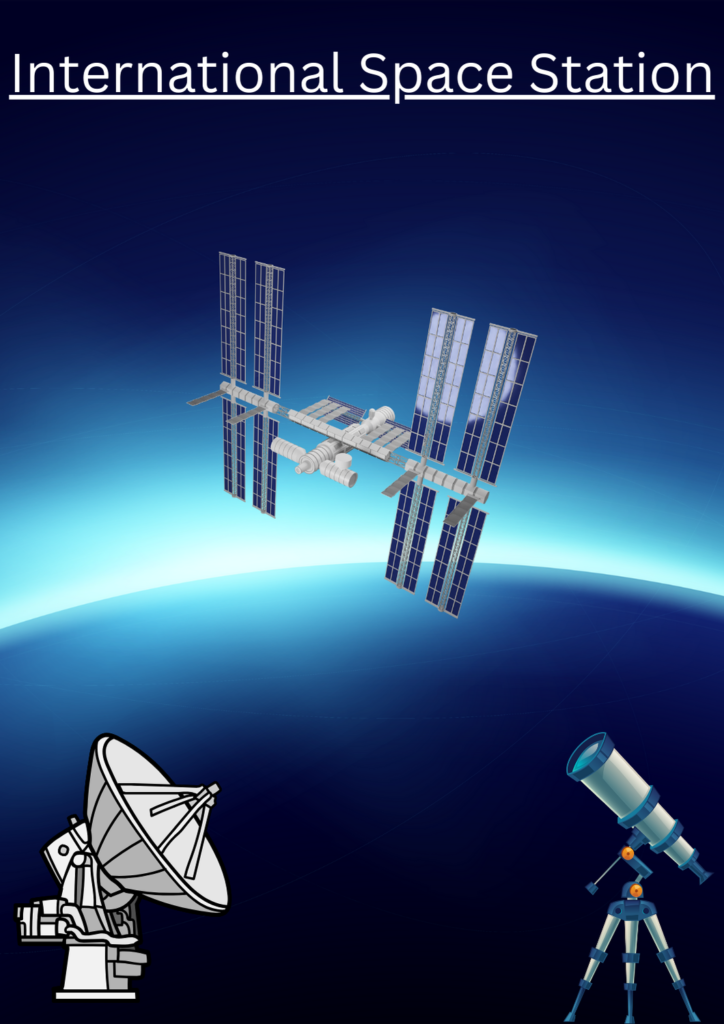Exploring the International Space Station

Introduction
The International Space Station (ISS) is a marvel of modern engineering and a symbol of global cooperation in space exploration. Orbiting Earth at an altitude of around 402 kilometers, the ISS serves as a research laboratory, observatory, and testbed for spaceflight technologies. In this post, we’ll explore the story of what happened long ago into the history and development of the ISS, explore what life is like for astronauts on board, discuss the significant scientific research conducted on the station, and look ahead to its future role in space exploration Exploring the International Space Station. History and Development of the International Space Station The International Space Station has its roots in the 1980s, when NASA proposed a modular, habitable space station. After years of planning and collaboration with international 5 partners Countries. Exploring the International Space Station
(1) NASA (United States)
(2) Ros cosmos (Russia)
(3) ESA (European Space Agency)
(4) JAXA (Japan Aerospace Exploration Agency)
(5) CSA (Canadian Space Agency)
The first ISS module was launched in 1998. Here are some key milestones in the International Space Station’s development. First ISS Module, Name Zarya (“Zarya,” which means “sunrise” in Russia), is Launched by Russia. Zarya Module Launch on November 20, 1998, the Russian Proton rocket launched the first module of the International Space Station, Zarya. It served as the initial control module and provided power, propulsion, and storage. It was designed and funded by Russia but built by Boeing, a U.S. company. Exploring the International Space Station
On October 31, 2000, a Russian Soyuz spacecraft carrying American astronaut Bill Shepherd and Russian cosmonauts Yuri Gidzenko and Sergei Krikalev was launched from the Baikonur Cosmodrome in Kazakhstan. They arrived at the ISS on November 2, 2000, the first crew arrives at the ISS, marking the beginning of continuous human presence on board at microgravity environment.Exploring the International Space Station
The ISS was completed in 2011, with a total mass of around 450,000 kilograms (1 million pounds). The assembly of the ISS took 10 years involving multiple launches and the installation of numerous modules, trusses, solar arrays, and other components to complete ISS. Exploring the International Space Station
Living and working on the International Space Station
Astronauts must adapt to microgravity, confined spaces, and a strict schedule is a unique experience. Exploring the International Space Station
(1) Astronauts sleep in private cabins, with sleeping bags attached to the wall to prevent floating away.
(2) Astronauts exercise for at least 2 hours a day to maintain muscle mass and bone density in microgravity.
(3) Meals are pre-prepared, pre-packaged, and consumed using special utensils and straws to prevent food and liquids from floating
away.
(4) Astronauts use a special toilet and shower system, with water recycled and purified for reuse.
Scientific Research on the International Space Station
The ISS serves as a laboratory for a wide range of scientific experiments, taking advantage of the unique conditions of space Exploring the International Space Station
(1) Studying the effects of microgravity on materials, fluids, and living organisms.
(2) Monitoring climate change, tracking natural disasters, and studying Earth’s natural resources.
(3) Testing technologies and strategies for deep space missions.
(4) Studying fluid dynamics, crystal growth, and materials properties in microgravity.
(5) Investigating plant growth, animal development, and microbial behavior in space.
(6) Monitoring climate change, tracking natural disasters, and studying Earth’s natural resources.
(7) Observing the universe, studying black holes, and detecting cosmic rays.
(8) Alpha Magnetic Spectrometer (AMS) Searching for dark matter and antimatter.
(9) Growing plants for food and oxygen future long duration missions.
Vegetables: (1) Lettuce (Lactuca sativa)
(2) Mizuna (Japanese mustard greens)
(3) Radishes
(4) Wheat) in space for future long duration missions.
(5) Dwarf tomatoes
Flowers: (1) Zinnias
Model Plant: (1) Arabidopsis thaliana
(10) Studying cosmic rays and their impact on Earth’s climate.
Future of the ISS and Space Exploration
The International Space Station has a planned operational lifespan until at least 2030, with ongoing discussions about extending its mission.
(1) NASA plans to open the ISS to private companies, allowing them to use the station for their own research and development.
(2) There are proposals to expand the ISS, adding new modules and facilities to enhance its research capabilities.
(3) The ISS will serve as a testing ground for technologies and strategies that will be used for the Lunar Gateway, a planned lunar-
orbiting space station.
(4) Research conducted on the ISS will help inform and prepare for future human missions to Mars.
(5) The ISS will continue to serve as a symbol of international cooperation in space exploration, with future collaborations and joint
missions.
Module on International Space Station
The International Space Station (ISS) has a total of 14 pressurized modules and 2 unpressurized modules. Exploring the International Space Station
Pressurized Modules:
(1) Zarya (Russia) – Functional Cargo Block
(2) Unity (USA) – Node 1
(3) Zvezda (Russia) – Service Module
(4) Destiny (USA) – Laboratory
(5) Harmony (USA) Node 2
(6) Kibo (Japan) Experiment Module
(7) Columbus (Europe) Laboratory
(8) Tranquility (USA) Node 3
(9) Cupola (USA) Observatory
(10) Rassvet (Russia) Mini-Research Module 1
(11) Leonardo (USA) Permanent Multipurpose Module
(12) Bigelow Expandable Activity Module (BEAM) (USA) Experimental Habitat
(13) Nauka (Russia) Multipurpose Laboratory Module
(14) Prichal (Russia) Uzlovoy Module (Node Module)
Unpressurized Modules:
(1) P6 Truss (USA) – Solar Array Wing
(2) S6 Truss (USA) – Solar Array Wing
Conclusion(International Space Station)
The International Space Station is a remarkable achievement in space exploration, representing a collaboration of nations and a hub for scientific discovery. As we look to the future, the ISS will continue to play a vital role in advancing our understanding of space and improving life on Earth. Exploring the International Space Station
Here’s a summary of the key points Exploring the International Space Station
(1) The ISS is a unique laboratory for scientific research, with experiments in various fields.
(2) The station has a planned operational lifespan until at least 2030, with possibilities for extension.
(3) Future plans include commercialization, expansion, and serving as a testing ground for lunar and Mars missions.
(4) International cooperation will continue to be a hallmark of the ISS program.
International Space Station
Here are the 20 facts about the International Space Station in a Q&A.
Q1: When was the first ISS module launched? Exploring the International Space Station
A1: November 20, 1998
Q2: How high does the ISS orbit Earth? Exploring the International Space Station
A2: Around 250 miles (400 kilometers)
Q3: How fast does the ISS travel? Exploring the International Space Station
A3: Approximately 17,500 miles per hour (28,200 kilometers per hour)
Q4: How long is the ISS?
A4: About 357 feet (109 meters)
Q5: How wide is the ISS?
A5: About 240 feet (73 meters)
Q6: What is the total mass of the ISS?
A6: Around 1 million pounds (450,000 kilograms)
Q7: How many astronauts/cosmonauts can the ISS accommodate?
A7: Up to 6
Q8: How many modules does the ISS have?
A8: 14 pressurized modules and 2 unpressurized modules
Q9: How much power do the ISS solar arrays generate?
A9: 84 kilowatts
Q10: What type of life support system does the ISS have?
A10: Closed-loop life support system, recycling air and water
Q11: How many scientific experiments are conducted on the ISS annually?
A11: Over 1,000
Q12: Who are the partners in the ISS program?
A12: NASA, Roscosmos, JAXA, ESA, and CSA
Q13: What is the estimated cost of building and operating the ISS?
A13: Over $1.3 trillion
Q14: What launch vehicles have been used to launch ISS modules?
A14: Space Shuttles, Proton rockets, and others
Q15: How many docking ports does the ISS have?
A15: 6
Q16: How many robotic arms does the ISS have?
A16: 2 (Canadarm2 and Dextre)
Q17: How many spacewalks have been performed from the ISS?
A17: Over 250
Q18: How long has the ISS been continuously occupied?
A18: Since November 2000
Q19: How is the ISS resupplied?
A19: By spacecraft like SpaceX’s Dragon and Northrop Grumman’s Cygnus
Q20: Until when is the ISS planned to operate?
A20: At least 2030

Your words feel like they’ve been chosen with the utmost care — each one placed to guide us towards greater understanding.